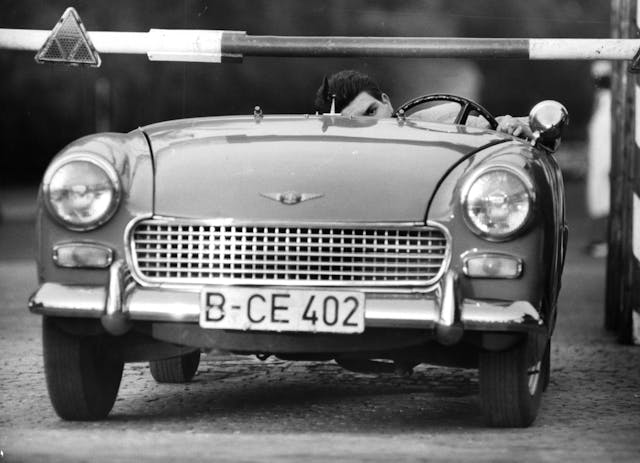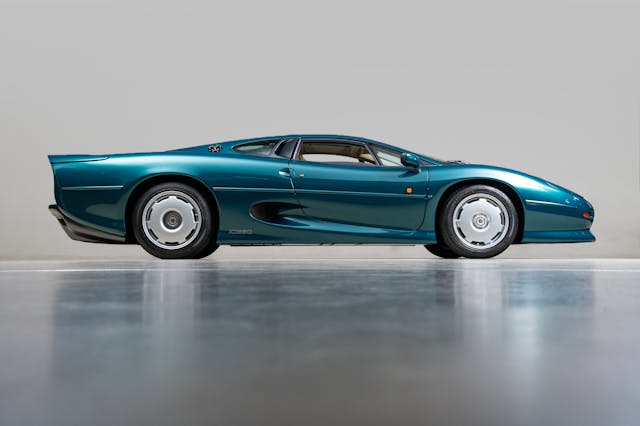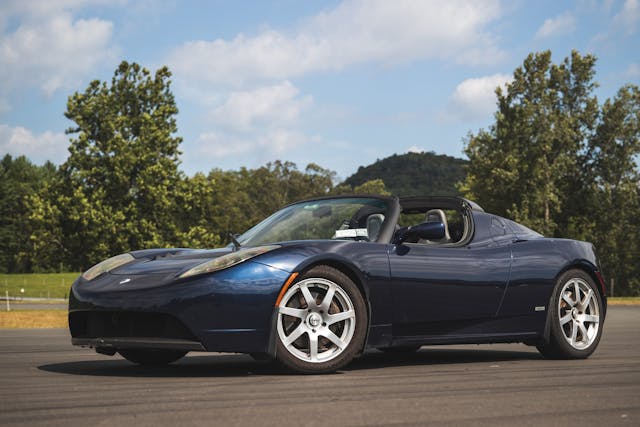5 Rides That Stumbled Last Quarter
We’ve discussed some of the notable gainers in the latest Hagerty Price Guide (we update it quarterly), but the fact remains that the market has continued to soften this year. We continue to see it in the Hagerty Market Rating, and many vehicles in the Hagerty Price Guide dropped as well. Much like the winners we highlighted a few weeks ago, the notable drops in our price guide are varied and come from across all segments of the hobby. Let’s dive in.
As always, if you have questions about how we arrived at these changes, you can read more about the methodology behind the Hagerty Price Guide here.
1954-57 Jaguar XK 140: -12%

Following the success of Jaguar’s first postwar sports car—the XK 120—the first update to the platform came in the form of the XK 140 in 1955. While it retained the race-proved 3.4-liter straight-six engine from the XK 120, it received a mild bump in power as well as quite a few cosmetic updates. In the Jaguar hierarchy, these are usually regarded as a bit less “pure” than the previous XK 120 but a bit less distinctive than the later, more refined XK 150, so a middle child effect exists and values reflect that.
The XK 140 experienced a steady period of growth from 2021 on, growing by 24-percent up until its peak in spring of 2023, however it is just now that we are seeing these gains start to walk back. Over the early part of this year, good quality cars started selling for much lower values than we’ve seen in nearly two years. While the sky isn’t falling and these are still valuable cars (the median condition #2 value is $110K), we are watching the market closely on these going into the Monterey auctions to see what happens.
1962-69 Austin-Healey Sprite: -11%

While already cheap and cheerful, the Austin-Healey Sprite (also sold as the Midget in MG form) just got a little cheaper. Small, British sports roadsters have always been a great way to enter the hobby. Many of the best ones still run less than $20,000 and if you’re pressed for room, they’ll fit in a one-stall garage with tons of space to spare. The best part is that if you’re somewhat mechanically inclined, the operating systems and the agricultural nature of the Sprite and its A-Series engine present a simple way to DIY repairs without too much trouble. If you want something as beginner friendly on the wallet and ownership experience as a Miata, but you want something more classical, then it’s hard to ignore the Sprite.
Cheap vehicles have also seen some of the most surprising growth over the past few years. Given the abundance of both Sprites and Midgets along with their inexpensive nature, then, an 11 percent drop here is something worth noting. In pure dollar terms the decrease isn’t much (the median #2 value is $13,200) and 1962-69 Sprites are now worth about what they were three years ago. Square-body Sprites (not to be confused with the earlier, more valuable Bugeyes) remain one of the few truly cheap classics left in the hobby, and staying cheap isn’t a bad thing.
1991-94 Jaguar XJ 220: -10%

While the Jaguar XJ 220 is one of the coolest and most unique offerings of the early 1990s, it is one that has struggled to garner the same accolades as its peers, namely the Ferrari F40, Porsche 959, and Bugatti EB 110. The other three are solidly seven-figure cars while the most pristine Jag is no more than $600,000. Why is this?
Looking back at the development history, the Jag was a bit of a compromise. When the concept debuted, it promised V-12 power and all-wheel drive. By the time Jaguar released the production version, it had half the cylinders driving half the wheels. It was still a wild-looking, 200-mph-capable car, but it wasn’t what buyers expected when they put down their deposit. And, even by supercar standards, XJ 220s are expensive cars to service. Even die-hard enthusiasts had a hard time getting past what these cars could’ve been, Jaguar had a hard-time selling them when they were new, and today’s collectors still have to deal with high operating costs.
Reputation goes a long way in this hobby and can either propel a car’s value and desirability or relegate it to the realm of it being interesting, but not a must-have. While the whole 1990s super car segment has been on fire, the Jaguar has struggled in comparison. While the XJ 220 did enjoy a decent value bump in 2022, values have pulled back since. The bottom line is that these look like they’re going to stay sub-million dollar cars for the foreseeable future.
2008-11 Tesla Roadster: -9%

Regardless of how you feel about EVs or their place as “interesting” or “collectible” cars, the original Tesla Roadster holds an important place in the development trajectory of the EV and in the automobile in general. This was the first serial production car to use lithium ion batteries, after all, as well as the first production EV to achieve a rated range of 244 miles (although BBC’s Top Gear famously and controversially disputed that), all while being able to hit 60 in under 4 seconds and thrill through the corners thanks to its Lotus Elise-derived underpinnings. While much of this is expected performance of EVs today, this was a technical marvel in the 2000s.
While the average reader here may find it a bit strange, there are EV collectors out there. And, given its significance, the Tesla Roadster is a must-have for them. That’s partly why the Tesla experienced a gradual lift in values over the past few years. More recently, however, Tesla Roadsters haven’t been selling as well and dropped to a median #2 value of $107K. In speaking with John Wiley, Director of Valuation Analytics, he observed that “there were four recent sales of the Tesla Roadster spanning the 2008-11 model years, with mileages ranging from 6,000 to 60,000. All sold below condition appropriate value.” With fewer than 2500 Roadsters built and sold to 30 countries, this is a significant amount of cars to come to market at the same time. Wiley continues: “Perhaps as the appeal of new EVs loses some charge, the original Tesla Roadster is a bit less appealing to enthusiasts.”
While this budding segment of enthusiast car still searches for mainstream appeal, there are bound to be hiccups. Talk to any EV fan, though, and there is little range anxiety about this segment dimming in the longer term.
1992-2006 Hummer H1: -7%

At the very opposite end of the efficiency spectrum from the eco-friendly Tesla sports car is a humongous truck that looks like it could keep OPEC happy all on its own. Jokes aside, the Hummer H1 is a seriously cool truck with a seriously cool background. First and foremost it was a replacement to the venerable Jeep in the military. The small Jeep left large shoes to fill, but the High Mobility Multipurpose Wheeled Vehicle (HMMW), aka Humvee, aka “Hummer” was more than capable of doing that job. While much larger than the Jeep, the HMMW took off-road capability to a whole new level with extreme ground clearance, fully independent suspension, locking differentials, and the ability to control tire inflation from the cabin on later models.
While surplus models have trickled out to the civilian market, a true customer version became available to the public in large part thanks to lobbying by actor Arnold Schwarzenegger. Earlier versions were civilianized versions of the Humvee, while the final year saw the introduction of the H1 Alpha, with an upgraded power plant using the 6.6-liter Duramax diesel instead of the previous Detroit Diesel plants. This upgrade makes the Alpha noticeably more sought after than earlier versions.
Hummers have struggled with an image problem. They’re big, almost too big for many road conditions, and are the in-your-face poster truck for gluttonous fuel consumption. It also seems that the market for H1s can be as mixed as people’s opinions on them. After some decent price growth in 2023, the past few months have seen dropping sale prices across all years and configurations. Falling demand may come from the fact that a good H1 is going to run you close to $100,000, and that can buy a tastefully restomodded vintage SUV that’s more usable than a Humvee and has none of the stigma.



Re-the XJ220, let me add: the opportunity may be now. There is a small shop in California with a reputation on par with Singer, that is updating XJ220s, making them even faster, reliable, and easy to own and maintain, while looking stock. I’ve heard there will be one at “The Quail” this month.
What the automotive press tends to leave out about the Jaguar XJ220 which I believe is part and parcel to its inability to catch on as a properly priced collector car is that like the McLaren F1, in fact until the McLaren F1, the Jaguar XJ220 was the fastest car in the world, and the XJ220 held the record at the the Nurburgring for street car, and above all else, it was the only supercar to win Le Mans! One more thing: it wasn’t just any V6 that powered the XJ220, it was the world championship winning Land Rover Rally car V6, and they chose it for its performance advantage over the V12.
Perhaps today’s writers don’t even know.
In other words: positive history. There is a lot of it.
It’s interesting that 3 of the 5 cars that lost value were British. With the Jaguar marquee having two cars in the mix. I am a Jaguar fan and I am familiar with the up and down swings in the Jaguar world. My prediction is the value will increase again over time. Nonetheless, I will hold on to my 3 Jags.
Not only are these cars out of the common man’s budget but they are ridiculously rare rending them almost irrelevant.
I love the varied opinions. That’s all they are. One person, followed by a few.
Some are bold and some are funny. All in all, an informative read.
I bought a brand new Austin Healey Sprite in 1964. I think I paid about $1600 for it. Met a guy who was a whiz at modifications. Shaved the head .100in and ported and polished the intakes. It was a fun car. Drove from Biloxi, Mississippi to Hartford, Connecticut with my new wife in June 1966 with all our possessions in that Sprite. Fun time.
Don’t forget there is a tesla roadster parts car floating around in space just in case you ever need an out of production part.
The Tesla Roadster evaluation is mostly wrong and conjecture. There are very specific reasons there is a Roadster glut right now, and none of them have to do with broader market EV’s losing appeal.
Gruber Motors sells more Tesla Roadsters than any other auction house or service. Feel free to check with us for trends, feedback, and reasons for selling.
Pete Gruber
i think it was in the late 90s or early 00s when the unloved xj220s were still trying to find owners and they were sooo cheap – always liked it and wish could’ve bought one back then. they were a great deal
Had a few sprites, they are fun but so small in relation to any other cars today (including Miata) that I felt quite vulnerable on the street. Low, small and zero crash protection, bad combination.
Nobody sees you
That’s right. You crash one, you’re dead.
Why does it always have to be about money how about which is the most fun to drive
Lucky for me the XK 140 in coupe form is pretty much my ultimate old English car / Jag.
I have a 1989 RX-7 convertible that has been serviced and cared for since 1990 (all service invoices have been saved). Painted black with black leather interior, 110,000 miles, always garaged/covered.